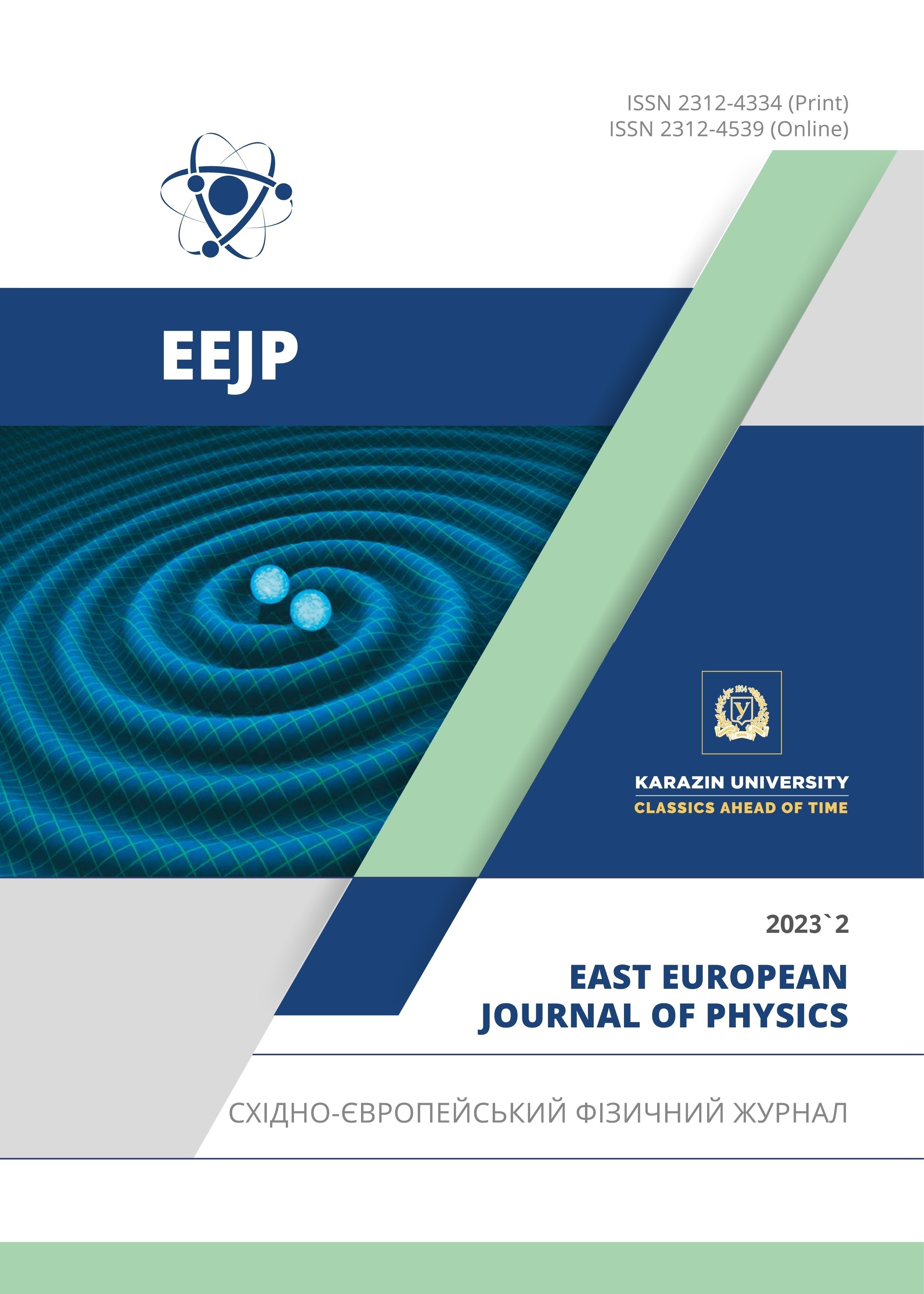Екситонна люмінесценція полікристалів Y2O3, що спечені з нанопорошку
Анотація
Стаття присвячена вивченню змін у рентгенлюмінесцентних спектрах нанорозмірної кераміки Y2O3, а саме випромінення, що пов’язане з самозахопленим екситоном. Додаткова теплова обробка (відпал) зразків кераміки призводить до змін у екситонній смузі спектрів. Це зміна форми та зсув максимуму цієї смуги. Довготривале опромінення зразків рентгенівськими фотонами з енергією 60 кеВ також призводило до змін у екситонній смузі. Теоретична модель, яка базується на експериментальних даних, пояснює зміни у спектрах. Енергетичним джерелом люмінесценції у цьому випадку є фотоелектрони утворені енергійними фотонами. На поверхні субмікрокристалів утворюються пастки для цих електронів. Зміни у співвідношенні поверхні з об’ємом кристалів, а також частот збуджених фононів та екситонів є базою для змін у спектрах рентгенолюмінесценції кераміки Y2O3.
Завантаження
Посилання
H. Tripathi, S. Kumar, Sh. Kumari, S. Bhardwaj, A. Gupta, and J. Sharma, Materials Today: Proceedings, (2023). https://doi.org/10.1016/j.matpr.2023.02.352 (in press).
D.R. Taikar, Journal of Alloys and Compounds, 828, 154405 (2020), https://doi.org/10.1016/j.jallcom.2020.154405
Hyeon-Myeong Oh, Young-Jo Park, Ha-Neul Kim, Jae-Woong Ko, Hyun-Kwuon Lee, Ceramics International, 47(4), 4681 (2021). https://doi.org/10.1016/j.ceramint.2020.10.035
Tóth, Álmos D., Ádám I. Szabó, Máté Zs. Leskó, Jan Rohde-Brandenburger, and Rajmund Kuti, Lubricants, 10(2), 28 (2022). https://doi.org/10.3390/lubricants10020028
A. Lushchik, M. Kirm, Ch. Lushchik, I. Martinson, and G. Zimmerer, Journal of Luminescence, 87, 232 (2000). https://doi.org/10.1016/S0022-2313(99)00271-9
S. Kononenko, E. Barannik, V. Zhurenko, O. Kalantaryan, V. Chishkala, R. Skiba, S. Lytovchenko, in: 2022 IEEE 12th International Conference Nanomaterials: Applications & Properties (NAP), Krakow, Poland, pp. NRA09-1-NRA09-4 (2022), https://doi.org/10.1109/NAP55339.2022.9934259
O. Kalantaryan, S. Kononenko, E. Barannik, V. Zhurenko and V. Chishkala, in: 2021 IEEE 11th International Conference Nanomaterials: Applications & Properties (NAP), (2021), pp. 1-4. https://doi.org/10.1109/NAP51885.2021.9568608
A. Konrad, U. Herr, R. Tidecks, F. Kummer, and K. Samwer, Journal of Applied Physics, 90, 3516 (2001). https://doi.org/10.1063/1.1388022
A. Kuznetsov, V. Abramov, N. Rooze, and T. Savikhina, Letters to Journal of Experimental and Theoretical Physics, 28, 602 (1978) (in Russian).
A. Kuznetsov, V. Abramov, and T. Uibo, Optical Spectroscopy, 58, 369 (1985) (in Russian).
Y. Mao, J. Engels, A. Houben, M. Rasinski, J. Steffens, A. Terra, Ch. Linsmeier, and J.W. Coenen, Nuclear Materials and Energy, 10, 1 (2017). http://dx.doi.org/10.1016/j.nme.2016.12.031
S.R. Sung. Ch. Zhu, and R. Miller, NASA Technical Memorandum, 212625 (2004), http://gltrs.grc.nasa.gov
Sh. Xu, Zh. Yao, J. Zhou, Ch. Fang, Materials Letters, 186, 349 (2017). https://doi.org/10.1016/j.matlet.2016.10.045
P.F. Yu, K. Zhang, S.X. Du, P. Ren, M. Wen, W.T. Zheng, Materials Science Forum, 898, 1516 (2017). https://doi.org/10.4028/www.scientific.net/msf.898.1516
Авторське право (c) 2023 Є. Баранник, С. Кононенко, В. Журенко, О. Калантар’ян, П. Кузнєцов

Цю роботу ліцензовано за Міжнародня ліцензія Creative Commons Attribution 4.0.
Автори, які публікуються у цьому журналі, погоджуються з наступними умовами:
- Автори залишають за собою право на авторство своєї роботи та передають журналу право першої публікації цієї роботи на умовах ліцензії Creative Commons Attribution License, котра дозволяє іншим особам вільно розповсюджувати опубліковану роботу з обов'язковим посиланням на авторів оригінальної роботи та першу публікацію роботи у цьому журналі.
- Автори мають право укладати самостійні додаткові угоди щодо неексклюзивного розповсюдження роботи у тому вигляді, в якому вона була опублікована цим журналом (наприклад, розміщувати роботу в електронному сховищі установи або публікувати у складі монографії), за умови збереження посилання на першу публікацію роботи у цьому журналі.
- Політика журналу дозволяє і заохочує розміщення авторами в мережі Інтернет (наприклад, у сховищах установ або на особистих веб-сайтах) рукопису роботи, як до подання цього рукопису до редакції, так і під час його редакційного опрацювання, оскільки це сприяє виникненню продуктивної наукової дискусії та позитивно позначається на оперативності та динаміці цитування опублікованої роботи (див. The Effect of Open Access).








